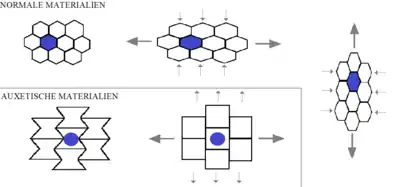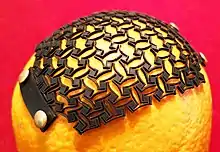Auxetics
Auxetics are structures or materials that have a negative Poisson's ratio. When stretched, they become thicker perpendicular to the applied force. This occurs due to their particular internal structure and the way this deforms when the sample is uniaxially loaded. Auxetics can be single molecules, crystals, or a particular structure of macroscopic matter. Such materials and structures are expected to have mechanical properties such as high energy absorption and fracture resistance. Auxetics may be useful in applications such as body armor,[1] packing material, knee and elbow pads, robust shock absorbing material, and sponge mops.

The term auxetic derives from the Greek word auxetikos (αὐξητικός) which means 'that which tends to increase' and has its root in the word auxesis (αὔξησις), meaning 'increase' (noun). This terminology was coined by Professor Ken Evans of the University of Exeter.[2][3] One of the first artificially produced auxetic materials, the RFS structure (diamond-fold structure), was invented in 1978 by the Berlin researcher K. Pietsch. Although he did not use the term auxetics, he describes for the first time the underlying lever mechanism and its non-linear mechanical reaction is therefore considered the inventor of the auxetic net. The earliest published example of a material with negative Poisson's constant is due to A. G. Kolpakov in 1985, "Determination of the average characteristics of elastic frameworks"; the next synthetic auxetic material was described in Science in 1987, entitled "Foam structures with a Negative Poisson's Ratio"[4] by R.S. Lakes from the University of Wisconsin Madison. The use of the word auxetic to refer to this property probably began in 1991.[5]
Designs of composites with inverted hexagonal periodicity cell (auxetic hexagon), possessing negative Poisson ratios, were published in 1985.[6]
Typically, auxetic materials have low density, which is what allows the hinge-like areas of the auxetic microstructures to flex.[7]
At the macroscale, auxetic behaviour can be illustrated with an inelastic string wound around an elastic cord. When the ends of the structure are pulled apart, the inelastic string straightens while the elastic cord stretches and winds around it, increasing the structure's effective volume. Auxetic behaviour at the macroscale can also be employed for the development of products with enhanced characteristics such as footwear based on the auxetic rotating triangles structures developed by Grima and Evans.[8][9][10]

Examples of auxetic materials include:
- Auxetic polyurethane foam[11][12]
- α-Cristobalite.[13]
- Liquid crystal polymers with rotating transverse rods could potentially be auxetic. Experimental pursuits towards producing materials auxetic at the molecular scale (and also in the macroscopic sense) have rarely been successful so far.[14]
- Crystalline materials: Li, Na, K, Cu, Rb, Ag, Fe, Ni, Co, Cs, Au, Be, Ca, Zn, Sr, Sb, MoS, BAsO and other.[15][16][17]
- Certain rocks and minerals[18]
- Graphene, which can be made auxetic through the introduction of vacancy defects[19][20]
- Carbon diamond-like phases[21]
- Noncarbon nanotubes[22][23]
- Living bone tissue (although this is only suspected)[18]
- Tendons within their normal range of motion.[24]
- Specific variants of polytetrafluorethylene polymers such as Gore-Tex[25]
- Paper, several types. If a paper is stretched in an in-plane direction it will expand in its thickness direction due to its network structure.[26][27]
- Several types of origami folds like the Diamond-Folding-Structure (RFS), the herringbone-fold-structure (FFS) or the miura fold,[28][29] and other periodic patterns derived from it.[30][31]

- Tailored structures designed to exhibit special designed Poisson's ratios.[33][34][35][36][37][38]
- Chain organic molecules. Recent researches revealed that organic crystals like n-paraffins and similar to them may demonstrate an auxetic behavior.[39]
- Processed needle-punched nonwoven fabrics. Due to the network structure of such fabrics, a processing protocol using heat and pressure can convert ordinary (not auxetic) nonwovens into auxetic ones.[40][41]
- Cork has an almost zero Poisson's ratio. This makes it a good material for sealing wine bottles.
See also
- Acoustic metamaterial
- Mechanical metamaterial
- Metamaterial
- Parallelogon
- Zetix, a type of commercially manufactured auxetic material
References
- "Hook's law". The Economist. 1 December 2012. Retrieved 1 March 2013.
- Quinion, Michael (9 November 1996), Auxetic.
- Evans, Ken (1991), "Auxetic polymers: a new range of materials.", Endeavour, 15 (4): 170–174, doi:10.1016/0160-9327(91)90123-S.
- Lakes, R.S. (27 February 1987), "Foam structures with a negative Poisson's ratio", Science, 235 (4792): 1038–40, Bibcode:1987Sci...235.1038L, doi:10.1126/science.235.4792.1038, PMID 17782252, S2CID 21386778.
- Evans, Ken (1991), "Auxetic polymers: a new range of materials", Endeavour, 15 (4): 170–174, doi:10.1016/0160-9327(91)90123-S.
- Kolpakov, A.G. (1985). "Determination of the average characteristics of elastic frameworks". Journal of Applied Mathematics and Mechanics. 49 (6): 739–745. Bibcode:1985JApMM..49..739K. doi:10.1016/0021-8928(85)90011-5.
- A stretch of the imagination – 7 June 1997 – New Scientist Space
- Grima, JN; Evans, KE (2000). "Auxetic behavior from rotating squares". Journal of Materials Science Letters. 19 (17): 1563–1565. doi:10.1023/A:1006781224002. S2CID 138455050.
- Grima, JN; Evans, KE (2006). "Auxetic behavior from rotating triangles". Journal of Materials Science. 41 (10): 3193–3196. Bibcode:2006JMatS..41.3193G. doi:10.1007/s10853-006-6339-8. S2CID 137547536.
- "Nike Free 2016 product press release".
- Li, Yan; Zeng, Changchun (2016). "On the successful fabrication of auxetic polyurethane foams: Materials requirement, processing strategy and conversion mechanism". Polymer. 87: 98–107. doi:10.1016/j.polymer.2016.01.076.
- Li, Yan; Zeng, Changchun (2016). "Room‐Temperature, Near‐Instantaneous Fabrication of Auxetic Materials with Constant Poisson's Ratio over Large Deformation". Advanced Materials. 28 (14): 2822–2826. doi:10.1002/adma.201505650. PMID 26861805.
- Yeganeh-Haeri, Amir; Weidner, Donald J.; Parise, John B. (31 July 1992). "Elasticity of α-Cristobalite: A Silicon Dioxide with a Negative Poisson's Ratio". Science. 257 (5070): 650–652. Bibcode:1992Sci...257..650Y. doi:10.1126/science.257.5070.650. ISSN 0036-8075. PMID 17740733. S2CID 137416819.
- Verma, Prateek; He, Chaobin; Griffin, Anselm C. (23 August 2020). "Implications for Auxetic Response in Liquid Crystalline Polymers: X‐Ray Scattering and Space‐Filling Molecular Modeling". physica status solidi (b): 2000261. doi:10.1002/pssb.202000261.
- Goldstein, R.V.; Gorodtsov, V.A.; Lisovenko, D.S. (2013). "Classification of cubic auxetics". Physica Status Solidi B. 250 (10): 2038–2043. doi:10.1002/pssb.201384233.
- Gorodtsov, V.A.; Lisovenko, D.S. (2019). "Extreme values of Young's modulus and Poisson's ratio of hexagonal crystals". Mechanics of Materials. 134: 1–8. doi:10.1016/j.mechmat.2019.03.017.
- Grima-Cornish, JN; Vella-Zarb, L; Grima, JN (2020). "Negative Linear Compressibility and Auxeticity in Boron Arsenate". Annalen der Physik. 532 (5): 1900550. Bibcode:2020AnP...53200550G. doi:10.1002/andp.201900550.
- Burke, Maria (7 June 1997), "A stretch of the imagination", New Scientist, 154 (2085): 36
- Grima, J. N.; Winczewski, S.; Mizzi, L.; Grech, M. C.; Cauchi, R.; Gatt, R.; Attard, D.; Wojciechowski, K.W.; Rybicki, J. (2014). "Tailoring Graphene to Achieve Negative Poisson's Ratio Properties". Advanced Materials. 27 (8): 1455–1459. doi:10.1002/adma.201404106. PMID 25504060.
- Grima, Joseph N.; Grech, Michael C.; Grima‐Cornish, James N.; Gatt, Ruben; Attard, Daphne (2018). "Giant Auxetic Behaviour in Engineered Graphene". Annalen der Physik. 530 (6): 1700330. Bibcode:2018AnP...53000330G. doi:10.1002/andp.201700330. ISSN 1521-3889.
- Rysaeva, L.Kh.; Baimova, J.A.; Lisovenko, D.S.; Gorodtsov, V.A.; Dmitriev, S.V. (2019). "Elastic properties of fullerites and diamond-like phases". Physica Status Solidi B. 256 (1): 1800049. Bibcode:2019PSSBR.25600049R. doi:10.1002/pssb.201800049.
- Goldstein, R.V.; Gorodtsov, V.A.; Lisovenko, D.S.; Volkov, M.A. (2014). "Negative Poisson's ratio for cubic crystals and nano/microtubes". Physical Mesomechanics. 17 (2): 97–115. doi:10.1134/S1029959914020027. S2CID 137267947.
- Bryukhanov, I.A.; Gorodtsov, V.A.; Lisovenko, D.S. (2019). "Chiral Fe nanotubes with both negative Poisson's ratio and Poynting's effect. Atomistic simulation". Journal of Physics: Condensed Matter. 31 (47): 475304. Bibcode:2019JPCM...31U5304B. doi:10.1088/1361-648X/ab3a04. PMID 31398716.
- Gatt R, Vella Wood M, Gatt A, Zarb F, Formosa C, Azzopardi KM, Casha A, Agius TP, Schembri-Wismayer P, Attard L, Chockalingam N, Grima JN (2015). "Negative Poisson's ratios in tendons: An unexpected mechanical response" (PDF). Acta Biomater. 24: 201–208. doi:10.1016/j.actbio.2015.06.018. PMID 26102335.
- Auxetic materials, 9 March 2001.
- Baum et al. 1984, Tappi journal, Öhrn, O. E. (1965): Thickness variations of paper on stretching, Svensk Papperstidn. 68(5), 141.
- Verma, Prateek; Shofner, ML; Griffin, AC (2013). "Deconstructing the auxetic behavior of paper". Physica Status Solidi B. 251 (2): 289–296. Bibcode:2014PSSBR.251..289V. doi:10.1002/pssb.201384243.
- Mark, Schenk (2011). Folded Shell Structures, PhD Thesis (PDF). University of Cambridge, Clare College.
- Lv, Cheng; Krishnaraju, Deepakshyam; Konjevod, Goran; Yu, Hongyu; Jiang, Hanqing (2015). "Origami based Mechanical Metamaterials". Scientific Reports. 4: 5979. doi:10.1038/srep05979. PMC 4124469. PMID 25099402.
- Eidini, Maryam; Paulino, Glaucio H. (2015). "Unraveling metamaterial properties in zigzag-base folded sheets". Science Advances. 1 (8): e1500224. arXiv:1502.05977. Bibcode:2015SciA....1E0224E. doi:10.1126/sciadv.1500224. ISSN 2375-2548. PMC 4643767. PMID 26601253.
- Eidini, Maryam (2016). "Zigzag-base folded sheet cellular mechanical metamaterials". Extreme Mechanics Letters. 6: 96–102. arXiv:1509.08104. doi:10.1016/j.eml.2015.12.006. S2CID 118424595.
- Mizzi, Luke; Salvati, Enrico; Spaggiari, Andrea; Tan, Jin-Chong; Korsunsky, Alexander M. (2020). "Highly stretchable two-dimensional auxetic metamaterial sheets fabricated via direct-laser cutting". International Journal of Mechanical Sciences. 167: 105242. doi:10.1016/j.ijmecsci.2019.105242. ISSN 0020-7403.
- Tiemo Bückmann; et al. (May 2012). "Tailored 3D Mechanical Metamaterials Made by Dip-in Direct-Laser-Writing Optical Lithography". Advanced Materials. 24 (20): 2710–2714. doi:10.1002/adma.201200584. PMID 22495906.
- Grima‐Cornish, James N.; Grima, Joseph N.; Evans, Kenneth E. (2017). "On the Structural and Mechanical Properties of Poly(Phenylacetylene) Truss-Like Hexagonal Hierarchical Nanonetworks". Physica Status Solidi B. 254 (12): 1700190. Bibcode:2017PSSBR.25400190G. doi:10.1002/pssb.201700190. hdl:10871/31485. ISSN 1521-3951.
- Cabras, Luigi; Brun, Michele (2014). "Auxetic two-dimensional lattices with Poisson's ratio arbitrarily close to −1". Proceedings of the Royal Society A: Mathematical, Physical and Engineering Sciences. 470 (2172): 20140538. arXiv:1407.5679. Bibcode:2014RSPSA.47040538C. doi:10.1098/rspa.2014.0538. ISSN 1364-5021.
- Carta, Giorgio; Brun, Michele; Baldi, Antonio (2016). "Design of a porous material with isotropic negative Poisson's ratio". Mechanics of Materials. 97: 67–75. doi:10.1016/j.mechmat.2016.02.012.
- Cabras, Luigi; Brun, Michele (2016). "A class of auxetic three-dimensional lattices". Journal of the Mechanics and Physics of Solids. 91: 56–72. arXiv:1506.04919. Bibcode:2016JMPSo..91...56C. doi:10.1016/j.jmps.2016.02.010. S2CID 85547530.
- Kaminakis, N; Stavroulakis, G (2012). "Topology optimization for compliant mechanisms, using evolutionary-hybrid algorithms and application to the design of auxetic materials". Composites Part B Engineering. 43 (6): 2655–2668. doi:10.1016/j.compositesb.2012.03.018.
- Stetsenko, M (2015). "Determining the elastic constants of hydrocarbons of heavy oil products using molecular dynamics simulation approach". Journal of Petroleum Science and Engineering. 126: 124–130. doi:10.1016/j.petrol.2014.12.021.
- Verma, Prateek; Lin, A; Wagner, KB; Shofner, ML; Griffin, AC (2015). "Inducing out-of-plane auxetic behavior in needle-punched nonwovens". Physica Status Solidi B. 252 (7): 1455–1464. Bibcode:2015PSSBR.252.1455V. doi:10.1002/pssb.201552036.
- Verma, Prateek; Shofner, Meisha L.; Lin, Angela; Wagner, Karla B.; Griffin, Anselm C. (2016). "Induction of auxetic response in needle-punched nonwovens: Effects of temperature, pressure, and time". Physica Status Solidi B. 253 (7): 1270–1278. Bibcode:2016PSSBR.253.1270V. doi:10.1002/pssb.201600072. ISSN 1521-3951.